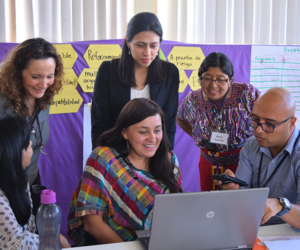Considerations
Considerations for the Strategic Design Process
Take the following factors into consideration before starting the strategy development process.
Alignment with National Strategies and Policies
Your environmental analysis should have identified any national-level strategies, policy documents or action plans for SBCC integration. Review these documents and their priorities, and factor them into your strategic design. Your integrated SBCC strategy needs to align with the country’s strategic direction and clearly demonstrate how it is contributing to national goals and targets. To help you determine how best to align with national priorities, think about the following questions:
- Are there vertical communication strategies for the different topic areas (e.g., a National Communication Strategy for Malaria Control or a National Family Planning Costed Implementation Plan)?
- Where are the areas of synergy in these strategies?
- Do some target the same audiences, or use the same communication channels?
- How might you blend these in your strategy?
Stakeholder Engagement and Coordination
During the strategic design process you will make key decisions about content, order and priorities. For integrated SBCC to retain buy-in from stakeholders, they must be actively engaged in this decision-making process. It is likely there will be trade-offs between topics, audiences, level of detail and other aspects of programming. Stakeholder involvement will help ensure they have a chance to deepen their understanding of their audiences’ needs, and the opportunity to provide input into how and when their issue will be covered.
In addition to the coordinating body, this phase of integrated SBCC programming is likely to involve the formation of smaller working groups or task forces. There may be sub-groups tasked to develop the initial draft of the strategy for the coordination body’s review, to work on developing creative concepts or to develop communication materials. You may hold strategy design, campaign design or materials development workshops for these purposes (see How to Conduct a Stakeholder Workshop for more information).
This is also an ideal time to involve the target audience in the process in order to co-create the strategy, concepts and materials with the people or groups they are meant to benefit, and help to ensure their relevance and success. Be sure to factor in the additional time and resources required for stakeholder coordination during this strategic design phase.
– (Changala, 2014)"Local input during the design process ensures better long-term solutions. The co-creation process is critical to restore agency and transfer responsibility, ownership and decision-making to enable exit. Developing and equipping local and national servant leaders to be able to design, manage and scale solutions is the key to long-term success in the fight to end extreme poverty. Using a co-creation design process for programs puts potential solutions through a rigorous vetting process to determine their suitability in any given project’s context for maximum impact"
Materials Inventory
When designing an integrated SBCC project, chances are that you will not be the first to develop communication materials on each of the various topics. Rather than re-invent the wheel, see what others have already produced in the areas of interest. Collect and catalogue existing materials and resources from partners to use later during the message design and materials development processes. Obtain both electronic and hard copies wherever possible to facilitate adaptation.
Program Experience
National Strategies Guide Design
(When you see a Program Experience, simply click on the photo to read insights from real integrated SBCC programs.)
Tip
Advocacy for the strategy is as important as the strategy itself. Advocate within the partnership to continually strengthen the strategy. Also advocate with communities by engaging traditional and religious leaders and other gatekeepers (e.g., in-laws and community groups) on the topics before and during implementation to get their support and participation.
Tip
If faced with challenges on what to prioritize, return to the shared vision and common goals set at the beginning of the project to determine the best course of action. They can act as a “compass” for navigating the design process, and help ensure the main objectives are at the heart of each activity (Edmond, et al., 2013).
Program Experience
Resources
See the list of Resources at the end of this section for examples of how integrated SBCC projects have inventoried materials. The Materials Adaptation How-to Guide can provide further guidance on how to update or modify these materials, once catalogued.



